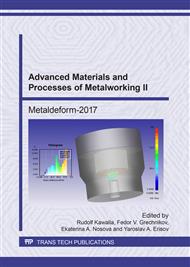p.84
p.92
p.99
p.108
p.114
p.120
p.126
p.132
p.141
Technological Parameters Forming the Surface Texture in Hyper Productive Surface Plastic Deformation Processing
Abstract:
The hyper productive surface plastic deformation processing technology called as wide burnishing (WB) was developed in Russian Federation. The mechanics of new WB technology is different from the classic SPD technologies (rolling or burnishing). For example applied force during processing of burnishing is 150-300 N, of WB is 2500-5000 N due to condition of process implementation in mass production with limited processing time (3-4 turnovers of workpiece). WB also has a high degree of deformation due to a multiple deformation passes. To determine the optimal WB processing parameters single and double instrumental devices were implemented and tested. Specimens made of steel 40 and high-strength cast iron 75-50-03 were tested. Initial roughness of steel 40 specimen’s surface was Ra = 0.5 microns and high-strength cast iron was Ra = 0.85 microns. Results of surface texture parameters of processed parts such as surface roughness Ra of steel 40 and high-strength cast iron 75-50-03 under varying load values P and number of cycles (the number of workpieces revolutions during the period of burnishing) were acquired. It was established that the minimum Ra value of the processed surface correspond with values of P = 210 N/mm2 for steel 40 and P = 410 N/mm2 for high-strength cast iron 75-50-03 regardless of number of burnishing cycles. Plastic deformation mechanism (processing time and pressure on the surface) influences on the processed surface roughness formation. It is possible to assume that straining state forms at the optimal values of P in terms of achieving a minimum value of Ra in which the reached degree of hardening allows to minimize the height of the microscopic irregularities of the previous grinding processing. In this case there is no plastic flow of the metal surface layer.
Info:
Periodical:
Pages:
114-119
Citation:
Online since:
July 2017
Authors:
Keywords:
Price:
Сopyright:
© 2017 Trans Tech Publications Ltd. All Rights Reserved
Share:
Citation:


